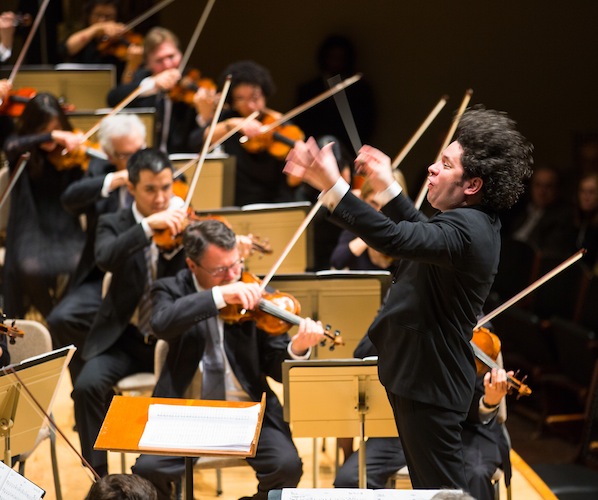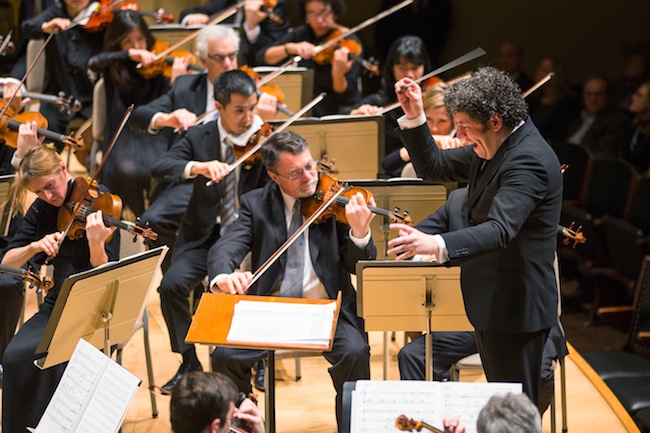Concert Review: A Gripping Los Angeles Philharmonic Orchestra at Symphony Hall
For at least the last decade, the LAPO has set the bar in creative programming, commissioning new works, and integrating itself into its community.

The LA Philharmonic and conductor Gustavo Dudamel in their Celebrity Series performance at Symphony Hall. Photo: Robert Torres.
By Jonathan Blumhofer
Thirty-one years is a long time between visits, especially when so much has happened in the interim. That’s how long it had been, until Sunday, since the Los Angeles Philharmonic Orchestra (LAPO) last was in Boston. In that time, the orchestra has gone from being a consistently good ensemble to, arguably, the country’s best: for at least the last decade, the LAPO has set the bar in creative programming, commissioning new works, and integrating itself into its community.
So it’s a bit of an understatement to say that the orchestra’s appearance at Symphony Hall this weekend, courtesy of the Celebrity Series, was highly anticipated. That it certainly was, but this is an ensemble that does just about everything right and, as the Boston Symphony eagerly looks forward to the start of Andris Nelsons’ tenure as music director this fall, one couldn’t help but sense on Sunday a special kind of hopeful enthusiasm from the audience that the BSO might soon bring the same kind of excitement and energy to its repertoire and performances that the LAPO and its charismatic young music director, Gustavo Dudamel, supply to theirs.
One of the characteristics that make the LAPO a great orchestra is the freshness with which it approaches the repertoire, and that was evident on Sunday’s program. As if to emphasize that the symphonic tradition doesn’t start with Beethoven and end with Brahms, the first half of Sunday’s program was given to John Corigliano’s Symphony no. 1. Subtitled “Of Rage and Remembrance,” it was written in 1988 after Corigliano viewed the AIDS quilt and the music memorializes some of the composer’s friends lost to the disease.
There is, understandably, plenty of apparent rage in the music – this is a symphony that pummels with unrelenting force – but the most moving moments aren’t the big ones. Rather, it’s the quiet sections that leave the greatest impression.
Such was the case in Sunday’s gripping performance, both in the first movement when, after a huge orchestral climax explodes into shards and fragments, an Albeniz tango emerges from a piano off-stage; and throughout the haunting third movement chaconne, Giulio’s Song. In the latter, Corigliano indicates, in the score, names of specific friends being recalled (the syllabic rhythms of the names being given to solo instruments). It’s a touching concept on paper and in this performance that lengthy, ruminative movement was imbued with poignant anguish, due in no small part to Robert deMaine’s masterful account of the involved cello solo.
So too, the grotesque second movement, a scherzo/tarantella that is meant to depict a descent into AIDS-induced dementia. The music leads to some awful places – it’s downright terrifying at times – but is filled with incredible orchestrational touches that the LAPO played to the hilt: muted trombones glissading downwards, strumming mandolins, an outlandish duet for contrabassoons in their lowest register, and so on.
At the end of the day, Corigliano’s First is about as theatrical a symphony as you could imagine – who else writes for dueling orchestral chimes? – but for the most part Corigliano’s gestures are well calculated and enhance the music’s dramatic punch. Indeed, now entering its second quarter-century, it’s safe to say that the piece has exceeded its original message and become a modern classic: a powerful, enduring work about loss and longing. In a nice touch, the composer was on hand Sunday to accept the big ovation that followed.
Like another young music director, the New York Philharmonic’s Alan Gilbert, Dudamel is a marvelous conductor of new music but not as consistent when it comes to the standard canon. So it was to a degree in Sunday’s second half, which featured a blistering run-through of Tchaikovsky’s Symphony no. 5 that might have benefited from a little more restraint.

LA Philharmonic and Gustavo Dudamel in their Celebrity Series performance at Symphony Hall. Photo: Robert Torres.
Sonically, though, this was a glorious performance, with rich string tone and decorous brass and wind playing. One little flub aside, principal horn Andrew Bain nailed the big second movement solo with a warm, burnished sonority, and a host of other principals delivered equally compelling accounts of their parts.
Interpretively, though, this wasn’t the most organic of readings. Dudamel dwelt a bit too much on some transitional passages in the first and last movements and underlined a couple of key structural points in the finale with an abrupt tempo shift that, to these ears, didn’t work.
Even so, there was great instrumental transparency throughout much of the performance, especially in the second and third movements. The latter ended up mirroring to a surprising degree the dazzling orchestral color in the scherzo of the Corigliano symphony, while the former was simply a beautiful essay in melodic development.
For an encore, Dudamel led the Philharmonic in the Polonaise from Tchaikovsky’s Eugene Onegin. After the ruckus the orchestra kicked up in both symphonies, their stamina in the loud, outer sections of this piece was especially impressive, nicely contrasting the restrained central part of the piece.
Jonathan Blumhofer is a composer and violist who has been active in the greater Boston area since 2004. His music has received numerous awards and been performed by various ensembles, including the American Composers Orchestra, Kiev Philharmonic, Camerata Chicago, Xanthos Ensemble, and Juventas New Music Group. Since receiving his doctorate from Boston University in 2010, Jon has taught at Clark University, Worcester Polytechnic Institute, and online for the University of Phoenix, in addition to writing music criticism for the Worcester Telegram & Gazette.
Tagged: Gustavo-Dudamel, LAPO, Los Angeles Philharmonic Orchestra
